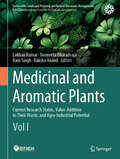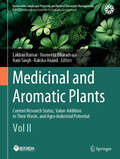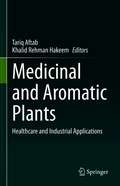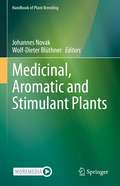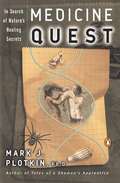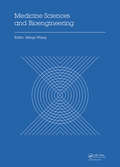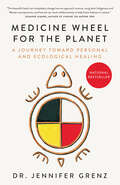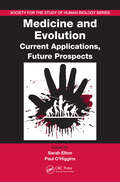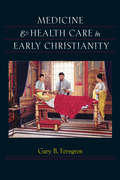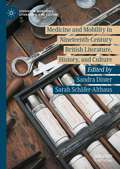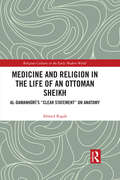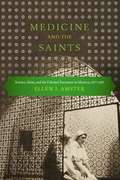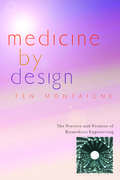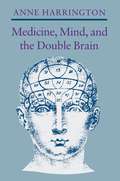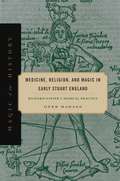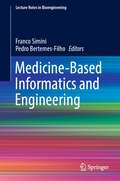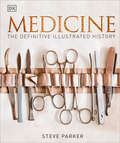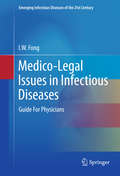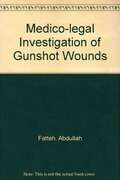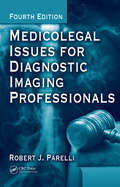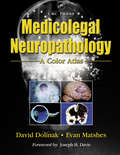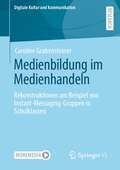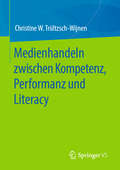- Table View
- List View
Medicinal and Aromatic Plants: Current Research Status, Value-Addition to Their Waste, and Agro-Industrial Potential (Vol I) (Sustainable Landscape Planning and Natural Resources Management)
by Ram Singh Navneeta Bharadvaja Lakhan Kumar Raksha AnandDue to complex phytochemical components and associated beneficial properties, numerous medicinal and aromatic plants, in whole or parts, have been used for nutritional purposes or the treatment of various diseases and disorders in humans and animals. Essential oils from medicinal and aromatic plants (MAPs) have been exploited for product formulations of pharmaceuticals, cosmetics, food and beverage, colorants, biopesticides, and several other utility chemicals of industrial importance. There is scientific evidence of many medicinal plant extracts possessing immunomodulatory, immunostimulatory, antidiabetic, anticarcinogenic, antimicrobial, and antioxidant properties, thus demonstrating their traditional use in popular medicine. With the advent of modern technology, the exploitation of natural resources has exponentially increased in order to fulfill the demand of an increased human population with improved quality of life. The traditional agriculture and production-based supply of commodities is inadequate to meet the current demand. Biotechnological approaches are gaining importance to bridge the gaps in demand and supply. In the proposed book, medicinal and aromatic plant-based secondary metabolites have been discussed in terms of their therapeutic potential and industrial relevance. To discuss the qualitative and quantitative analysis of a range of medicinal and aromatic plants-based secondary metabolites (SMs), bioprocess development for their extraction and bioseparation, a brief overview of their industrial relevance, various tissue culturing strategies, biotechnological approaches to enhance production, scale-up strategies, management of residual biomass post extraction of target SMs is central to the idea of the proposed book. A section will explore the verticals mentioned above. In the next section, the book addresses the approaches for conserving and improving medicinal and aromatic plant genetic resources. In the third section, approaches to managing the post-harvest crop residue and secondary metabolites extracted plant biomass will be thoroughly discussed. The recent integration of artificial intelligence to improve medicinal and aromatic plant research at several levels, including the development and employment of computational approaches to enhance secondary metabolite production, tissue culture, drug design and discovery, and disease treatment, will be included in the fourth section. The book summarizes current research status, gaps in knowledge, agro-industrial potential, waste or residual plant biomass management, conservation strategies, and computational approaches in the area of medicinal and aromatic plants with an aim to translate biotechnological interventions into reality.
Medicinal and Aromatic Plants: Current Research Status, Value-Addition to Their Waste, and Agro-Industrial Potential (Vol II) (Sustainable Landscape Planning and Natural Resources Management)
by Ram Singh Navneeta Bharadvaja Lakhan Kumar Raksha AnandDue to complex phytochemical components and associated beneficial properties, numerous medicinal and aromatic plants, in whole or parts, have been used for nutritional purposes or the treatment of various diseases and disorders in humans and animals. Essential oils from medicinal and aromatic plants (MAPs) have been exploited for product formulations of pharmaceuticals, cosmetics, food and beverage, colorants, biopesticides, and several other utility chemicals of industrial importance. There is scientific evidence of many medicinal plant extracts possessing immunomodulatory, immunostimulatory, antidiabetic, anticarcinogenic, antimicrobial, and antioxidant properties, thus demonstrating their traditional use in popular medicine. With the advent of modern technology, the exploitation of natural resources has exponentially increased in order to fulfill the demand of an increased human population with improved quality of life. The traditional agriculture and production-based supply of commodities is inadequate to meet the current demand. Biotechnological approaches are gaining importance to bridge the gaps in demand and supply. In the proposed book, medicinal and aromatic plant-based secondary metabolites have been discussed in terms of their therapeutic potential and industrial relevance. To discuss the qualitative and quantitative analysis of a range of medicinal and aromatic plants-based secondary metabolites (SMs), bioprocess development for their extraction and bioseparation, a brief overview of their industrial relevance, various tissue culturing strategies, biotechnological approaches to enhance production, scale-up strategies, management of residual biomass post extraction of target SMs is central to the idea of the proposed book. A section will explore the verticals mentioned above. In the next section, the book addresses the approaches for conserving and improving medicinal and aromatic plant genetic resources. In the third section, approaches to managing the post-harvest crop residue and secondary metabolites extracted plant biomass will be thoroughly discussed. The recent integration of artificial intelligence to improve medicinal and aromatic plant research at several levels, including the development and employment of computational approaches to enhance secondary metabolite production, tissue culture, drug design and discovery, and disease treatment, will be included in the fourth section. The book summarizes current research status, gaps in knowledge, agro-industrial potential, waste or residual plant biomass management, conservation strategies, and computational approaches in the area of medicinal and aromatic plants with an aim to translate biotechnological interventions into reality.
Medicinal and Aromatic Plants: Healthcare and Industrial Applications
by Khalid Rehman Hakeem Tariq AftabBefore the concept of history began, humans undoubtedly acquired life benefits by discovering medicinal and aromatic plants (MAPs) that were food and medicine. Today, a variety of available herbs and spices are used and enjoyed throughout the world and continue to promote good health. The international market is also quite welcoming for MAPs and essential oils. The increasing environment and nature conscious buyers encourage producers to produce high quality essential oils. These consumer choices lead to growing preference for organic and herbal based products in the world market. As the benefits of medicinal and aromatic plants are recognized, these plants will have a special role for humans in the future. Until last century, the production of botanicals relies to a large degree on wild-collection. However, the increasing commercial collection, largely unmonitored trade, and habitat loss lead to an incomparably growing pressure on plant populations in the wild. Therefore, medicinal and aromatic plants are of high priority for conservation. Given the above, we bring forth a comprehensive volume, “Medicinal and Aromatic Plants: Healthcare and Industrial Applications”, highlighting the various healthcare, industrial and pharmaceutical applications that are being used on these immensely important MAPs and its future prospects. This collection of chapters from the different areas dealing with MAPs caters to the need of all those who are working or have interest in the above topic.
Medicinal, Aromatic and Stimulant Plants (Handbook of Plant Breeding #12)
by Johannes Novak Wolf-Dieter BlüthnerThe agricultural sector of medicinal (including plant stimulants) and aromatic plants is characterized by an enormous number and diversity of species. Only a few of them can be considered cultivated crops in which significant breeding efforts are made. For most species, however, breeding is performed in short-term projects only. Therefore, basic knowledge about these species is still fragmentary. Our intention is to compile and organize the available information on the most commonly utilized plant species into one publication, thereby providing a standardized resource for the researchers and the grower community. This book therefore provides reference source materials for a wide variety of plant species used for human consumption due to their flavor, medicinal or recreational properties. It is divided into a section of general topics on genetic resources, breeding adaptation of analytic methods and a compilation of basic data for DNA content, chromosome number and mating system followed by a section of 20 monographs on a species or species groups.
Medicine Quest: In Search Of Nature's Healing Secrets
by Mark PlotkinIn Medicine Quest, Mark Plotkin moves beyond the Amazon rainforests of his classic Tales of a Shaman's Apprentice to describe the ongoing race to find new medicines for intractable diseases such as AIDS, cancer, diabetes, and tuberculosis in far-flung places all over the world. While highlighting the unlikely marriage of natural products, indigenous wisdom, and biotechnology, Plotkin details discoveries that are producing stunning results in the laboratory: painkillers from the skin of rainforest frogs, anticoagulants from leech saliva, and antitumor agents from snake venom. An entertaining and educational weave of medicine, ecology, ethnobotany, history, exploration, and adventure, Medicine Quest will thrill scientists, naturalists, and armchair explorers, and heighten our appreciation for the inexhaustible therapeutic potential of our natural world.
Medicine Sciences and Bioengineering: Proceedings of the 2014 International Conference on Medicine Sciences and Bioengineering (ICMSB2014), Kunming, Yunnan, China, August 16-17, 2014
by Mings WangThis proceedings volume contains selected papers presented at the 2014 International Conference on Medicine Sciences and Bioengineering (ICMSB 2014), held August 16-17, 2014 in Kunming, Yunnan, China. ICMSB2014 was aimed at researchers, engineers, industrial professionals and academics, who were broadly welcomed to present their latest research res
Medicine Wheel for the Planet: A Journey toward Personal and Ecological Healing
by Dr. Jennifer Grenz"This beautiful book can completely change how we approach science, using both Indigenous and Western perspectives, and how we can work collaboratively to help foster balance in nature." —Suzanne Simard, bestselling author of Finding the Mother TreeA farm kid at heart, and a Nlaka'pamux woman of mixed ancestry, Dr. Jennifer Grenz always felt a deep connection to the land. However, after nearly two decades of working as a restoration ecologist in the Pacific Northwest, she became frustrated that despite the best efforts of her colleagues and numerous volunteers, they weren't making the meaningful change needed for plant, animal and human communities to adapt to a warming climate. Restoration ecology is grounded in an idea that we must return the natural world to an untouched, pristine state, placing humans in a godlike role—a notion at odds with Indigenous histories of purposeful, reciprocal interaction with the environment. This disconnect sent Dr. Grenz on a personal journey of joining her head (Western science) and her heart (Indigenous worldview) to find a truer path toward ecological healing.In Medicine Wheel for the Planet, building on sacred stories, field observations and her own journey, Dr. Grenz invites readers to share in the teachings of the four directions of the medicine wheel: the North, which draws upon the knowledge and wisdom of elders; the East, where we let go of colonial narratives and see with fresh eyes; the South, where we apply new-old worldviews to envision a way forward; and the West, where a relational approach to land reconciliation is realized. Eloquent, inspiring and disruptive, Medicine Wheel for the Planet circles toward an argument that we need more than a singular worldview to protect the planet and make the significant changes we are running out of time for.
Medicine and Evolution: Current Applications, Future Prospects
by Sarah Elton Paul O’HigginsCan an evolutionary perspective be integrated in day-to-day practice and is it of value in medical education and training? If so, when and how? Highlighting exciting areas of research into the evolutionary basis of health and disease, Medicine and Evolution: Current Applications and Future Prospects answers these questions and more. I
Medicine and Health Care in Early Christianity
by Gary B. FerngrenDrawing on New Testament studies and recent scholarship on the expansion of the Christian church, Gary B. Ferngren presents a comprehensive historical account of medicine and medical philanthropy in the first five centuries of the Christian era.Ferngren first describes how early Christians understood disease. He examines the relationship of early Christian medicine to the natural and supernatural modes of healing found in the Bible. Despite biblical accounts of demonic possession and miraculous healing, Ferngren argues that early Christians generally accepted naturalistic assumptions about disease and cared for the sick with medical knowledge gleaned from the Greeks and Romans.Ferngren also explores the origins of medical philanthropy in the early Christian church. Rather than viewing illness as punishment for sins, early Christians believed that the sick deserved both medical assistance and compassion. Even as they were being persecuted, Christians cared for the sick within and outside of their community. Their long experience in medical charity led to the creation of the first hospitals, a singular Christian contribution to health care.
Medicine and Mobility in Nineteenth-Century British Literature, History, and Culture (Studies in Mobilities, Literature, and Culture)
by Sandra Dinter Sarah Schäfer-AlthausMedicine and Mobility in Nineteenth-Century British Literature, History, and Culture analyses the cultural and literary histories of medicine and mobility as entangled processes whose discourses and practices constituted, influenced, and transformed each other. Presenting case studies of novels, poetry, travel narratives, diaries, ship magazines, skin care manuals, asylum records, press reports, and various other sources, its chapters identify and discuss diverse literary, historical, and cultural texts, contexts, and modes in which medicine and mobility intersected in nineteenth-century Britain, its empire, and beyond, whereby they illustrate how the paradigms of mobility studies and the medical humanities can complement each other.
Medicine and Religion in the Life of an Ottoman Sheikh: Al-Damanhuri’s "Clear Statement" on Anatomy (Religious Cultures in the Early Modern World)
by Ahmed RagabIn 1768, Aḥmad al-Damanhūrī became the rector (shaykh) of al-Azhar, which was one of the most authoritative and respected positions in the Ottoman Empire. He occupied this position until his death. Despite being a prolific author, whose writings are largely extant, al-Damanhūrī remains almost unknown, and much of his work awaits study and analysis. This book aims to shed light on al-Damanhūrī’s diverse intellectual background, and that of and his contemporaries, building on and continuing the scholarship on the academic thought of the late Ottoman Empire. The book specifically investigates the intersection of medical and religious knowledge in Eighteenth-Century Egypt. It takes as its focus a manuscript on anatomy by al-Damanhūrī (d. 1778), entitled "The Clear Statement on the Science of Anatomy (al-qawl al-ṣarīḥ fī ʿilm al-tashrīḥ),". The book includes an edited translation of The Clear Statement, which is a well-known but unstudied and unpublished manuscript. It also provides a summary translation and analysis of al-Damanhūrī’s own intellectual autobiography. As such, the book provides an important window into a period that remains deeply understudied and a topic that continues to cause debates and controversies. This study, therefore, will be of keen interest to scholars working on the "post-Classical" Islamic world, as well as historians of religion, science, and medicine looking beyond Europe in the Early Modern period.
Medicine and Religion: A Historical Introduction
by Gary B. FerngrenExplores the interplay of medicine and religion in Western societies.Medicine and Religion is the first book to comprehensively examine the relationship between medicine and religion in the Western tradition from ancient times to the modern era. Beginning with the earliest attempts to heal the body and account for the meaning of illness in the ancient Near East, historian Gary B. Ferngren describes how the polytheistic religions of ancient Mesopotamia, Egypt, Greece, and Rome and the monotheistic faiths of Judaism, Christianity, and Islam have complemented medicine in the ancient, medieval, and modern periods.Ferngren paints a broad and detailed portrait of how humans throughout the ages have drawn on specific values of diverse religious traditions in caring for the body. Religious perspectives have informed both the treatment of disease and the provision of health care. And, while tensions have sometimes existed, relations between medicine and religion have often been cooperative and mutually beneficial. Religious beliefs provided a framework for explaining disease and suffering that was larger than medicine alone could offer. These beliefs furnished a theological basis for a compassionate care of the sick that led to the creation of the hospital and a long tradition of charitable medicine.Praise for Medicine and Health Care in Early Christianity, by Gary B. Ferngren"This fine work looks forward as well as backward; it invites fuller reflection of the many senses in which medicine and religion intersect and merits wide readership."—JAMA"An important book, for students of Christian theology who understand health and healing to be topics of theological interest, and for health care practitioners who seek a historical perspective on the development of the ethos of their vocation."—Journal of Religion and Health
Medicine and the Saints: Science, Islam, and the Colonial Encounter in Morocco, 1877-1956.
by Ellen J. AmsterThe colonial encounter between France and Morocco took place not only in the political realm but also in the realm of medicine. Because the body politic and the physical body are intimately linked, French efforts to colonize Morocco took place in and through the body. Starting from this original premise, Medicine and the Saints traces a history of colonial embodiment in Morocco through a series of medical encounters between the Islamic sultanate of Morocco and the Republic of France from 1877 to 1956. Drawing on a wealth of primary sources in both French and Arabic, Ellen Amster investigates the positivist ambitions of French colonial doctors, sociologists, philologists, and historians; the social history of the encounters and transformations occasioned by French medical interventions; and the ways in which Moroccan nationalists ultimately appropriated a French model of modernity to invent the independent nation-state. Each chapter of the book addresses a different problem in the history of medicine: international espionage and a doctor’s murder; disease and revolt in Moroccan cities; a battle for authority between doctors and Muslim midwives; and the search for national identity in the welfare state. This research reveals how Moroccans ingested and digested French science and used it to create a nationalist movement and Islamist politics, and to understand disease and health. In the colonial encounter, the Muslim body became a seat of subjectivity, the place from which individuals contested and redefined the political.
Medicine by Design: The Practice and Promise of Biomedical Engineering
by Fen MontaigneA heart that once beat erratically has regained its natural rhythm. A woman paralyzed by an automobile accident is now able to resume her favorite hobby. Physicians using a robotic surgeon named da Vinci perform lifesaving operations. These are some of the feats of biomedical engineering, one of the fastest-moving areas in medicine. In this exhilarating book, award-winning writer Fen Montaigne journeys through this little-known world, sharing the stories of ordinary people who have been transformed by technology. From the almost commonplace pacemaker to the latest generation of artificial hearts, Montaigne tells the stories of pioneering patients, engineers, and surgeons. Taking the reader behind the scenes of a dozen of America's leading centers of biomedical engineering, Montaigne recounts the field's history while describing cutting-edge work in medical imaging, orthopedics, cardiovascular care, neurological therapies, and genetics. Through the stories of patients whose lives have been saved and improved by biomedical devices, Montaigne reveals the marriage of medicine and engineering to be one of society's greatest advances.
Medicine, Mind, and the Double Brain: A Study in Nineteenth-Century Thought
by Anne HarringtonThe description for this book, Medicine, Mind, and the Double Brain: A Study in Nineteenth-Century Thought, will be forthcoming.
Medicine, Religion, and Magic in Early Stuart England: Richard Napier's Medical Practice (Magic in History)
by Ofer HadassThe astrologer-physician Richard Napier (1559-1634) was not only a man of practical science and medicine but also a master of occult arts and a devout parish rector who purportedly held conversations with angels. This new interpretation of Napier reveals him to be a coherent and methodical man whose burning desire for certain, true knowledge contributed to the contemporary venture of putting existing knowledge to useful ends.Originally trained in theology and ordained as an Anglican priest, Napier later studied astrological medicine and combined astrology, religious thought, and image and ritual magic in his medical work. Ofer Hadass draws on a remarkable archive of Napier’s medical cases and religious writings—including the interviews he claimed to have held with angels—to show how Napier’s seemingly inconsistent approaches were rooted in an inclusive and coherent worldview, combining equal respect for ancient authority and for experientially derived knowledge. Napier’s endeavors exemplify the fruitful relationship between religion and science that offered a well-founded alternative to the rising mechanistic explanation of nature at the time.Carefully researched and compellingly told, Medicine, Religion, and Magic in Early Stuart England is an insightful exploration of one of the most fascinating figures at the intersection of medicine, magic, and theology in early modern England and of the healing methods employed by physicians of the era.
Medicine, Religion, and Magic in Early Stuart England: Richard Napier's Medical Practice (Magic in History)
by Ofer HadassThe astrologer-physician Richard Napier (1559-1634) was not only a man of practical science and medicine but also a master of occult arts and a devout parish rector who purportedly held conversations with angels. This new interpretation of Napier reveals him to be a coherent and methodical man whose burning desire for certain, true knowledge contributed to the contemporary venture of putting existing knowledge to useful ends.Originally trained in theology and ordained as an Anglican priest, Napier later studied astrological medicine and combined astrology, religious thought, and image and ritual magic in his medical work. Ofer Hadass draws on a remarkable archive of Napier’s medical cases and religious writings—including the interviews he claimed to have held with angels—to show how Napier’s seemingly inconsistent approaches were rooted in an inclusive and coherent worldview, combining equal respect for ancient authority and for experientially derived knowledge. Napier’s endeavors exemplify the fruitful relationship between religion and science that offered a well-founded alternative to the rising mechanistic explanation of nature at the time.Carefully researched and compellingly told, Medicine, Religion, and Magic in Early Stuart England is an insightful exploration of one of the most fascinating figures at the intersection of medicine, magic, and theology in early modern England and of the healing methods employed by physicians of the era.
Medicine-Based Informatics and Engineering (Lecture Notes in Bioengineering)
by Franco Simini Pedro Bertemes-FilhoThis book originates from the idea to adapt biomedical engineering and medical informatics to current clinical needs and proposes a paradigm shift in medical engineering, where the limitations of technology should no longer be the starting point of design, but rather the development of biomedical devices, software, and systems should stem from clinical needs and wishes. Gathering chapters written by authoritative researchers, working the interface between medicine and engineering, this book presents successful attempts of conceiving technology based on clinical practice. It reports on new strategies for medical diagnosis, rehabilitation, and eHealth, focusing on solutions to foster better quality of life through technology, with an emphasis on patients’ and clinical needs, and vulnerable populations. All in all, the book offers a reference guide and a source of inspiration for biomedical engineers, clinical scientists, physicians, and computer scientists. Yet, it also includes practical information for personnel using biomedical equipment, as well as timely insights that are expected to help health agencies and software firms in their decision-making processes.
Medicine: The Definitive Illustrated History (DK Definitive Visual Histories)
by DKSee the greatest medical breakthroughs come to life through superb illustrations!From ancient herbal medicine to traditional Chinese medicine, take a visual tour throughout the history of medicine with this comprehensive medical reference book.Discover medicine through time! Here&’s what you&’ll find in this illustrated history book about medicine: • Offers a broad and accessible visual history of medicine — from the first herbal remedies to efforts surrounding the COVID-19 pandemic • Intriguing narratives are illustrated with photographs, paintings and artifacts • Offers a vivid, compelling and informative read written in an engaging and colourful style • Excerpts from documents, diaries and notebooks offer fascinating eyewitness accounts This medicine history book charts fascinating developments in diagnosis, surgery, healing and drugs through the ages. Feature spreads explore key medical concepts in detail and enhance the reader&’s understanding of human anatomy, surgical instruments and medical developments. Clear diagrams explain major diseases like cancer, and trace the progression of medical treatment through time, from ancient healing arts to scurvy and smallpox to modern psychiatry. Double-page features tell the story of the men and women involved in the extraordinary evolutions of this scientific field — from Hippocrates to Florence Nightingale.It's the perfect book for medical professionals, students of medicine or anyone with a keen interest in medicine, science or social history.
Medico-Legal Issues in Infectious Diseases
by I. W. FongThe aim of this book is not to encourage defensive medical practice, but to help provide better, optimum care to patients and to be forth right and honest to our dear customers about our inevitable mistakes. This book will focus on clinical issues facing physicians in different settings (which can lead to malpractice), and the best approach to use to avoid litigations, and practice good medicine.
Medicolegal Investigation of Gunshot Wounds
by Adbullah FattehWas written by an expert who at the time was a D.M.E. a visiting professor of Pathology and a consultant to the Criminal Justice Institute at Fort Lauderdale, Florida. Clearly written and easily understood, the book deals with all aspects of medicolegal investigation of gunshot wounds and deaths.The duties and responsibilities of the medical investigators and the police are explicitly outlined and guidelines are established for co-operative efforts between the two. The investigation of homicides, suicides, and accidents involving firearms, including investigation of the scene of the injury or death.
Medicolegal Issues for Diagnostic Imaging Professionals
by Colin M. Howles Zeev Shoham Robert J. Parelli David. K WeissmanThe constant advances in diagnostic imaging have had an impact on the practice, attitudes, and moral values of all who participate in health care. Now in its fourth edition, the original Medicolegal Issues for Radiographers has been updated and retitled, broadening the scope of content to include issues essential to all diagnostic imaging pr
Medicolegal Neuropathology: A Color Atlas
by Evan W. Matshes David DolinakWith nearly 600 autopsy photographs, this atlas shows various trauma and diseases of the brain and spinal cord in the forensic context of sudden death investigation. It also provides a simple, straight forward, concise text organized in a primarily case-oriented format. Unlike most other neuropathology texts, attention is given to skull fractures and scalp injuries. Where necessary, radiologic and microscopic images have also been included to facilitate learning along with a brief general anatomy of the brain and spinal cord. Thus pathologists who are not specialized in neuropathology can compare a variety of autopsy findings with cases illustrated in the text.
Medienbildung im Medienhandeln: Rekonstruktionen am Beispiel von Instant-Messaging-Gruppen in Schulklassen (Digitale Kultur und Kommunikation #11)
by Caroline GrabensteinerWie entfaltet sich Bildung angesichts der Handlungsmöglichkeiten in digitalen Medien? In dieser Grounded-Theory Studie werden Fragen zu Medienbildung und Medienhandeln verknüpft. Das Phänomen Instant-Messaging-Gruppen in Schulklassen steht im Zentrum der Analyse. Ergebnis ist ein Theoriemodell zur Rekonstruktion der Herstellung von Selbst- und Weltrelationen auf materialer, sozialer und biografischer Ebene im Prozess der Konstruktion von Handlungskontexten, Themen und sozialen Praktiken der Medienkommunikation mit dem Potenzial zur Erweiterung auf andere Soziale Medien.
Medienhandeln zwischen Kompetenz, Performanz und Literacy
by Christine W. Trültzsch-WijnenDas Buch diskutiert die soziale und individuelle Bedingtheit von Medienkompetenz. Im Mittelpunkt steht die Frage, wie sich das Medienhandeln von Individuen im Hinblick auf deren Medienkompetenz, im Sinne eines sicheren und selbstbestimmten Handelns im Umgang mit Medien, erklären und beurteilen lässt. Dies setzt eine Betrachtung des Medienhandelns vor dem Hintergrund der Beziehungen zwischen der Kompetenz zu Handeln, als Summe von Fähigkeiten, Fertigkeiten und Wissen sowie der kognitiven Beherrschung von Regeln des Verhaltens (moralische Regeln, rechtliche Regeln sowie Regeln der Klugheit), und der Performanz, als tatsächliches Handeln eines Individuums, voraus. Dabei wird auf theoretischer Ebene der Frage nach der sozialen Determinierung eines selbstbestimmten Handelns im Umgang mit Medien einschließlich dafür erforderlicher Fähigkeiten, Fertigkeiten sowie des damit verbundenen Wissens nachgegangen. Außerdem wird das Verhältnis des deutschsprachigen Medienkompetenzdiskurses zum internationalen Diskurs über media literacy erläutert. Es werden Gemeinsamkeiten und Unterschiede herausgearbeitet und Potentiale für eine gegenseitige Befruchtung beider Perspektiven aufgezeigt. Darüber hinaus wird die empirische Relevanz und Anwendbarkeit dieser theoretischen Überlegungen anhand zweier Studien illustriert.
